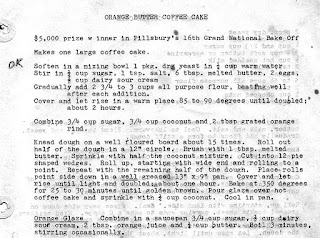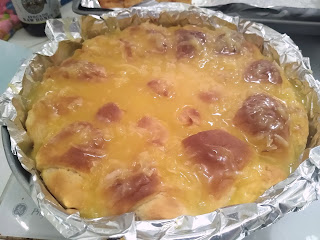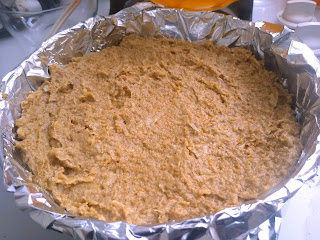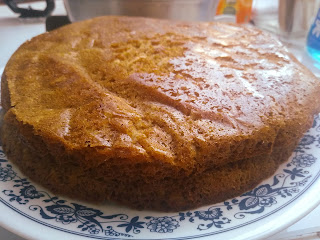Today's recipe begins with a handwritten note.
This is my great-grandmother's handwriting. Photos of her show a woman with her hair always
in a plain bun and wearing determinedly sensible clothes regardless of
the decade, like Marilla in Anne of Green Gables. Apparently she was "a cranky old woman who didn't like children," which is a wonderful goal to aspire to. This paper scrap turned up in an unexamined box of things, pressed between a lot of very
old studio photographs of people with last names that no one knows how
to fit into the family tree anymore.
But let's have a look at the recipe. Does it count as a family recipe if no one remembers it? There are no instructions, nor do we have a title to give us any hint about what this is a recipe for. I eventually sent it to friends asking what
they thought of it. Gabby (who has been seen for not one but two Pieathlons) said it looked like it might be a cake.
Graham Cracker and Coconut Cake
4 oz (about one cup*) coconut
1 c sugar
½ c butter
1 c milk
8 oz graham cracker crumbs
3 eggs
1 tsp baking powder
Heat oven to 350°. Grease two 8" round cake pans. This cake will really want to stick, so consider lining the pan with foil or cutting a parchment paper circle to put in the bottom.†
Beat the butter, baking powder, and sugar until light. Add the eggs one at a time, beating until fluffy. Alternately add the crumbs (in three additions) and milk (in two additions), starting and ending with the crumbs. Stir in the coconut.
Pour into the pans and spread it evenly. Bake 15-20 minutes, or until they are nice and springy when pressed in the center.
Put lemon filling§ between the layers and white frosting on the outside, or double the frosting recipe and put it between the layers also. (You might try setting aside some of the frosting and adding lemon extract to put in the middle of the cake.)
White frosting:
Powdered sugar
2 tbsp butter
1 egg white‡
Beat the butter and about one quarter cup of powdered sugar until thoroughly mixed and a little whipped. Add the egg white and beat until completely mixed. Add powdered sugar until it is the right thickness to spread.
*One tablespoon less than one cup if you want to be a bit more exact.
†If you're wondering why you only put paper on the bottom of a cake pan and not the sides also, it's easier to cut around the sides of the pan if the cake sticks than it is to try to peel foil or paper off the sides without taking chunks of cake with it.
To make very sure the cake will freely fall out of the pan, spray the whole pan and then stick the paper onto it, pressing out as many bubbles as you can. Then spray the pan again so the paper is coated on top.
‡If you're worried about raw eggs, use 3 tablespoons of egg whites from a carton. Shake it well right before you measure. They are pasteurized, so you don't need to worry about raw eggs.
§The recipe for lemon filling I found didn't work so well, which is why you don't see it here. Just use a recipe you like for lemon cake filling, or take the short cut and buy a jar of lemon curd (which is usually sold on the same grocery shelf as the jellies, preserves, and jams).
Source: undated recipe card (mid-1920s?)
|
I find it interesting that she wrote no instructions at all, but wrote out package sizes for all the ingredients. One rarely finds such exact detail in the ingredients list without equally explicit instructions. But despite not giving us any directions for what to do with our ingredients, she has saved us from what is usually the hardest part of making vaguely-written recipes: trying to find out how big the average grocery-store box of graham crackers or package of coconut was when this recipe came out. Unlike the many cookie recipes in various community cookbooks that just say "one bag of chocolate chips" without telling you what size, we have precise measurements. It's odd to write down how big a box of coconut the recipe uses but not how big of a cake pan (assuming this is a recipe for cake).
Let's start with the crackers. I could have bought graham cracker crumbs, but the rest of the box would have sat uneaten and unused. Therefore, I got un-crumbified crackers so that we could just eat the ones that didn't go into the cake.
When this recipe was new, I'm sure it would have been easy to measure the requisite 8 ounces of graham crackers. The crackers were sold in 1-pound boxes, so you just needed to use half of them. But in the intervening decades, the grocery store shrink ray has attacked these boxes:
 |
Pictured: NOT one pound of graham crackers.
|
I have to detour here and share with you the spectacularly unfortunate sentence of gleeful copy at the top of the box:
 |
You won't be having fun for long!
|
Anyway, despite lacking a kitchen scale we figured out how many crackers would make 8 ounces. We then decided to turn them into crumbs the modern way:
 |
I keep forgetting we have this thing, but it's very handy when I remember it exists.
|
Actually, let's stop everything for a minute. This recipe has no instructions at all. I'm sure most of the instructions are just "mix it all together." But are we supposed to just stir the eggs in, or should we separate them, beat the whites stiff, and fold them in at the end for a bit of extra lift? I was pretty sure we're meant to make this the easy way because this recipe has off-the-shelf measurements (one box coconut, one plastic sleeve of crackers, etc). Usually, this means that the recipe comes from someone who keeps their cooking as simple as possible. But the baking powder seemed rather scant compared how much batter it will theoretically raise. Perhaps it needed a starting push from the prewhipped foam.
I could have made two cakes, but cranking out a small convoy of cake layers was only fun when I could take them to all to a party and ask my friends for their honest opinions. Since no one in their right mind is about to all gather in someone's small living room in the next few months, we can't spread the calories around 10 or 15 people like we used to.
To resolve this self-made dilemma, I reminded myself that a dishwasher lives in this kitchen and chose to split this recipe in half and make it twice. We would make one cake layer with separated and whipped-up egg whites, and one without. If I only went with only one method I would forever wonder if I chose the wrong one. It would torment me whenever my thoughts went idle. Unfortunately for halving the ingredients, the recipe calls for three eggs. This led to something I avoid whenever possible: dividing the white and yolk of an egg in half.
I'm glad the recipe specifies "one box cocoanut ¼ lb" because all the bags of coconut we find today are a lot bigger. Had the recipe just said "one box coconut" with no measurement, I would have accidentally tripled the amount using one standard-issue 12-ounce bag of white shreds. The back of the bag gave us a nice starting hint for getting four(ish) ounces of coconut without a scale to weigh it:
That's right, the serving size on the nutrition facts tells us that two tablespoons contain fifteen grams of coconut. Doing some recipe math, we converted grams to ounces, figured out how to get four of them, converted that back to tablespoons, and arrived at the following result: 4 ounces of coconut is about one cup minus one tablespoon.
Anyway, with all our ingredients measured out, we decided to start this recipe with the method that like more
work: separating off and beating the egg whites at the end. Things temporarily looked like a normal cake recipe. We've got butter and sugar. So many cake recipes start out with "Cream the butter and sugar," and they almost always end well.
This next part looks normal if you don't think about the fact that someone got so persnickety about recipe methods that they cut egg yolks into fractions. It's true that you can easily subdivide eggs if you buy them in a carton and measure them out, but we would not have used the rest of the carton after this one recipe.
And here is where the recipe ventures into new and exciting territory! Usually we would add flour at this point. And perhaps one could point out that the pulverized crackers contain rather a lot of it, but the point is that we are using these things instead.
If you, like me, love the taste of graham cracker crust, you would have wondered where this batter-in-progress has been all your life. It looks like a brown paste that will never become a cake, but it tastes so good that you might eat it all before the oven ever sees it.
At this point, I started to think that this paste would become like one of the more disappointing recipes that begin with "Crush one sleeve of graham crackers" and ends with someone saying "Eh, I guess it's not bad..." It did not look like a cake batter at all, nor did it resemble cookie dough or anything else that this untitled recipe might have been. Was there a reason this recipe was stashed in the bottom of a box instead of handed around and passed down? Would this bake into something lovely, or would it just get heat-hardened in the oven?
As you can see, we have about equal amounts of crumb paste and coconut. As I stared at this hard-looking paste, I wondered if I had found written evidence for why no one ever mentions my great-grandmother's cooking.
If, according to our working hypothesis, this is supposed to be a cake, this already looks like failure. But since we had come so far, we decided to just get the whipped egg whites into it and see if it looked like it'd turn into something worth baking.
Actually, that looks a lot more like a cake batter than I thought it would. And as aforementioned, if you like graham cracker crusts you'd have happily eaten this in its current unbaked state. However, I still had doubts that we'd get anything good on the other side of the oven. I didn't expect anything awful, but I was almost certain that we'd try this and be like "...eh it's okay I guess." I was so certain this would be a waste of time that I only baked it because the oven was already hot and the pan was ready to receive batter. It looks a bit too lumpy (even after you realize a lot of those bumps are the coconut), but into the oven it went.
Ordinarily, once you have your cake in the oven you can start cleaning up. However, because I can't stop overthinking about whether we should have separate egg whites out, we are instead beginning over and making another cake.
This time, for cake layer #2, we are doing this the easy way. Instead of separating out egg whites and beating them into peaks, we're just dropping all the ingredients in the bowl where the electric mixer waits.
While the mixer does all the work for me, let's try to track down this recipe's source. Since few recipes come from nothing, I first looked up graham cracker cakes to find a lookalike. The idea seems fairly widespread (though obviously not as omnipresent as chocolate cakes), but all of the recipes I found put at least a little flour in the cake batter (if not equal-ish amounts flour and cracker crumbs). I didn't find anything resembling today's recipe in ingredients and amounts. Regardless of whether I allowed for the variations that happen as a recipe gets handed and passed around, I didn't find anything that looked like it started out from the same recipe that this one might have come from.

We're only two ingredients into the recipe and it already looks different from attempt number one. At this point with version #1, we had a clumpy paste. This time, we have something creamy and dreamy. With that said, it's still just the butter, sugar, and eggs. This part never goes badly; you have to get further into the recipe before you know whether you have made something good.
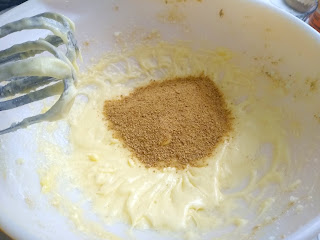
Continuing with our recipe digging, I tried to find recipes that would make a cake involving some combination of graham cracker crumbs, coconut, lemon filling, and white icing-- regardless of whether it looked like this one or not. I found a lot of recipes for graham cracker and coconut cake, graham cracker cake stacked with lemon filling, and other various combinations of graham cracker, coconut, and lemon. However, I didn't find anything that looked like a close relative of the recipe we have on brittle paper in wax pencil. I hesitate to say that this may be an original recipe, but I didn't see anything like it in any of the websites of archived cookbooks that I read for fun on a cozy storming night. However, it's reasonably likely that she took a graham cracker cake recipe and added the coconut and the lemon filling herself. Or perhaps she took a coconut cake recipe and substituted graham crumbs for flour.
 |
It looks more like a cake batter than the paste we made before.
|
I also tried to date the recipe card itself. The paper has two names printed on it, so I looked them up. "William P Feeney" was very elusive, even when I tried to narrow it down to a William P Feeney who was involved with the Cook County Democratic Party. A search for "James M. Dailey," however, turned up this photo of him from 1924 announcing his demise. So, assuming that this recipe was written on a new piece of scrap paper instead of something that sat in a drawer for several years, it's from before that year.
The batter is a little less stiff than the whipped-whites version. It got a little stiffer after adding the coconut, but it wasn't quite so dishearteningly paste-like as attempt #1. I'm pretty sure that this is how it was originally made. This recipe seems like the creation of someone who wanted to keep things as straightforward as possible with absolutely all time-consuming extra steps removed.
I should note that cake version #1 had been baking the whole time we were cleaning off the countertop splatters and then mixing this one together. By now, the oven had emitted a lot of wonderful smells that had spread from the kitchen and into the house. Others were drifting in, asking when it would be ready. But despite the lovely smells and resulting high hopes, the batter for cake #2 still didn't look very promising as it landed in a lumpy tan-colored mound in the pan.
 |
From the kitchen of one of my great grandmothers, everybody!
|
It really doesn't look any different from version #1 after spreading it out, furthering my theory that we should have just put the egg white whipper away and taken the short route through the recipe.
At any rate, we can now move on to the lemon filling! This terse recipe card provides no instructions for it (perhaps you could buy it in a jar even then?). So in my desire to be as plausibly-correct as possible, I poked around and found a recipe from a Chicago community cookbook dated to 1905.
This insistence on a period-correct filling recipe was as unnecessary as splitting the cake ingredients in half and making it two ways. All the lemon cake fillings I found, from the one you see below to ones posted on various websites as recently as last week, were all extremely similar. But to indulge my pickiness, this lemon recipe comes from the right area, and from it's a bit before this recipe. Thus, it was already out there and accessible to someone in 1924 making a cake out of graham crackers.
 |
The North End Club Cookbook, Chicago, 1905
|
Seems pretty easy, doesn't it?
I got everything into the pot that the recipe said I should. I made sure to slowly pour the boiling water in while stirring hard so that the egg didn't curdle. I put it over boiling water as directed, and fifteen minutes later there was absolutely no visible change. However, it was steaming hot and all the lemon juice had cooked out, leaving us with some pretty bland goop. I don't know if the recipe was faulty or if they liked their cake filling to be barely thicker than water. But on the bright side, we had bottled lemon juice on hand so I didn't waste any fresh lemons on this culinary misfire.
At this point, I just dumped more lemon juice into the pot to make up for the
flavor that boiled away and decided to stack this project together. As you can see, the beaten-whites cake got a lot darker on top than the other one.
As aforementioned, others in the house were periodically wandering in the kitchen to see what smelled so good and when it would be ready to eat. One person looked at the cooling cakes while I stirred the filling, pointed to the one I made the easy way, and said "This one's got bigger holes on top." Would you like to see for yourself?
Since both cakes had almost cooled, it seemed an ideal time to bring forth a suitable platform on which to perform final assembly. It's more than slightly strange to actually put together a layer cake when you're not taking it anywhere. How many people construct layer cakes just to have at home on a weeknight? Well, at least, how many people constructed layer cakes just to have at home on a weeknight before we were all sent to our homes by microbes?
 |
I am pleased to report that the cake absolutely did not stick to the pan.
|
I think I should have used a smaller pan. It almost looks like an extra-wide pancake.
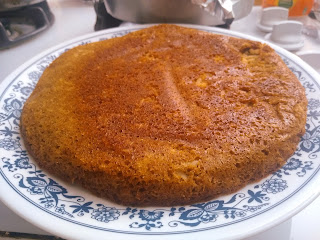 |
This recipe has traveled across almost a century to bring us a brown patty.
|
All right, so let's talk about what we're supposed to spread on this
cake. The front of the card has the ingredients for the cake itself, for
white frosting, and a two-word note: "lemon filling." The back of the
card has the same frosting as the front (this time giving us a
measurement for the butter instead of just saying to use a little),
written under the label "white filling." I can think of three
possibilities: 1) you're supposed to do a three-layer cake and put white
filling at one level and lemon on the other, 2) either white or lemon
is an acceptable choice, or 3) she used the words "frosting" and
"filling" interchangeably. At first I thought she might have just reused
the back of this to write down an unrelated white cake filling recipe,
as that would be the same sort of cheapskatery one would find with
someone who won't even use fresh blank paper to write out recipes (did
they not have notepads in the house?). But since we are directed to turn
the card over and consult the back for further instructions, we can
safely say that all of the writing on this card is one recipe.
I decided to go with option 2, that it's up to you whether you put white or lemon filling in this cake. I would have done a three-layer cake and used both fillings, but you'd need a really tiny pan to get three cakes out of this much batter unless you are deliberately making it very thin. Granted, perhaps we are meant to make three cake layers barely thicker than the icing between them, but I didn't think that would be as good. If this cake is going to be three layer cake, we'll have to make it in three tiny pans.

And so, we dropped cake layer #2 onto cake layer #1. I've never made a cake held together entirely with graham crackers before, and I thought these might be too crumbly to get out of the pan intact. However, the cake survived a fairly rough de-panning. I ended up inverting the pan over my hand and holding up the cake like a cocktail tray over my hand while I peeled the foil off of it before flipping it over without plate-support and dropping it onto the waiting lemon-topped first one. This cake is resilient, if a bit sticky.
And now, it is time to complete the cake! We're back onto the recipe card. She may not have written the lemon part, but we do have the icing. You might think that putting a raw egg white into cake icing and then leaving it out at room temperature is a spectacular way to get food poisoning, but sugar is an excellent preservative. Any microbes that land on sugar get immediately dried out. Since icing is almost all sugar, I was quite that we would (probably) be fine.
Furthermore, I've never made icing where you dumped in egg whites and wanted to know how (or if) it changed what we get. As we added a bit more powdered sugar, it was a bit more gelatinous than icing tends to be.
Even as we added more powdered sugar until the icing was thick enough to put on the sides of the cake without it dripping right off the vertical surface, it was just a little bit smoother than other batches of icing we've made. I think since egg whites kind of set and hold a shape themselves (a bit), we needed less powdered sugar to make this into something you could ice a cake with. However, that does not mean I iced this cake very well.

I can make no excuse for the cake top's sad state, but I have to defend the pathetic sides. Even with that barely-upturned dinner plate rim, it is very hard to get a knife in there to smooth out the sides. You can't do that bit where you hold the knife at an angle and scrape around the sides to even out and redistribute the icing-- there's porcelain in the way. Also, a dinner knife makes a lousy icing spreader. You have to keep pushing and rearranging the icing because the blade is too short to just reach all the way across the cake and swipe the icing into place in a few cake-covering strokes. The more you have to mess with the icing to get it spread out, the more it is going to pick up those dreaded crumbs. This is why I usually just glaze cakes. You can just dump the stuff on top and it will make itself perfect (or at least good enough).
But with that said, we do get the perfect amount of icing for this cake. It's enough to cover it, but not so much that you'll have to scrape the excess off to avoid a sugar overload. The thin icing does give further support to my guess that I should have used smaller pans. That would have made the cake less short and flat. And the icing would have gone just a little further. But we can consider possible recipe revisions after we cut a piece of this thing and ask ourselves: is it actually any good?
 |
The icing doesn't look so bad once you cut it.
|
Yes. Yes it is. If you like the graham cracker crust under a cheesecake almost as much as the cheesecake itself, this cake is for you. I did not expect it to be this good. Graham cracker, coconut, and lemon under white icing are a combination I need more of in my life. To my surprise, we got an actual cake out of this and not some gummy paste disaster. The texture is surprisingly similar to the yellow cake recipe we used to crank out for birthdays.
You couldn't find any difference between the two cake layers unless you were really trying to tell them apart. But really, they are so similar that without the (smaller than I wish) line of lemon to divide them, it'd be very hard to see where one stops and the other starts. If you really tried to distinguish them, you'd find that the separated-whites cake was a little drier-- but it did cut a bit more neatly. (It's the layer on the bottom. But if you couldn't tell without reading that, then you can easily see that separately whipping the whites made nearly no difference.) So not only is the easy way easier, but it's also better.
